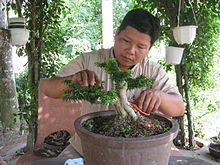Leaf cut (plants)

The sheet cut is a cut method in horticulture . The leaves of a tree or other plant are cut off in order to stimulate the plant to sprout new leaves and shoots .
Basics
In contrast to topiary cutting , only the leaves are removed when cutting leaves, but the branches and twigs are not cut.
By removing the leaves, the plant is no longer able to photosynthesize . The plant's "built-in survival instinct" means that it quickly sprouts new leaves on all branches. During the leafless period, the plant's metabolism is greatly reduced and it also uses less water because its evaporation surface is reduced to almost zero.
In nature, unexpected frost or animals that eat the leaves can lead to similar situations. Most plants are therefore “prepared” for the situation of total leaf loss and react by quickly sprouting new leaves.
motivation
The technique of leaf cutting is mainly used for bonsai . It has the following advantages:
- The tree forms more side shoots and is finer branched.
- The newly sprouted leaves are slightly smaller and therefore better match the size of the bonsai.
- Old and no longer so beautiful leaves are replaced by new ones.
- After wiring , the old leaves may be twisted unnaturally. The new leaves reorient themselves according to gravity and light.
In the case of outdoor bonsai (deciduous trees), the leaf cut simulates an “artificial autumn”. By cutting the leaves in early summer, the tree bears new, young leaves twice instead of once a year. The colorful autumn foliage is even more beautiful due to the smaller leaf size after the leaf has been cut.
Even with larger evergreen tropical-subtropical houseplants that do not know autumn (e.g. Ficus benjamina or Schefflera ), a complete leaf cut helps if the plant already has one for some reason (e.g. disease, vermin, drafts, dehydration) Has lost part of its leaves or the leaves are no longer beautiful for some reason (e.g. mottled, dusty, sticky). An old and ugly houseplant can be "rejuvenated" again by the simple method of leaf cutting and become as beautiful as new.
techniques
With normal leaf cutting, all leaves are completely removed. Use a pair of scissors (e.g. small nail scissors or the traditional Japanese nigiri ) to carefully cut off each leaf at the center of the petiole. It is important not to tear off the leaves or to cut them too close to the branch so as not to damage the bud in the axilla of the petiole. The new shoot sprouts from this bud after the leaf cut. The remainder of the cut petiole will dry up and, on most plants, fall off on its own after a week or two.
There is also a “gentler” variant of the leaf cut. With this, each leaf is initially only trimmed to half or a third of the leaf area. After the new leaves have sprout, the remains of the old leaves can be removed completely. With this variant, the "shock" is less for the plant. However, it does double the work when cutting and you have to be very careful with the second cut not to damage the new leaves and shoots with the scissors. Therefore, this variant is mainly used for small plants with comparatively few leaves, e.g. B. Bonsais, applied.
Disadvantages and Risks
It hurts the soul of many plant friends to cut off the leaves of their plants, especially the young and beautiful leaves. However, if 10 percent of the leaves are left in place, there is a risk that the plant will not need to sprout all of the leaves and will accordingly remain bare.
One of the disadvantages of leaf pruning is that the plant is bare for a few weeks after it is cut. In addition, diseased plants run the risk that they no longer have enough strength to sprout again.
Leaf pruning should generally only be carried out during the growing season, not during the winter break.
In the case of large indoor plants with several hundred leaves, cutting the leaves is a tedious and time-consuming job.
Lawn clippings
A variant of leaf cutting is mowing the lawn . Mowing works on the same principle: each grass plant is stimulated to sprout new leaves by the cut, so that it grows more densely. With this, the growth of taller weeds and mosses is inhibited by light deprivation and displacement and a healthier lawn cover is produced.
In the case of lawns, regular leaf pruning therefore also supports the grass plants in their competition with other, horticulturally undesirable plants.
literature
- Johann Kastner: Growing, designing and maintaining bonsai . Gräfe and Unzer, Munich 2013, ISBN 978-3-8338-3452-3
- Oliver Kipp: Designing Asian gardens . Gräfe and Unzer, Munich 2013, ISBN 978-3-8338-1879-0

